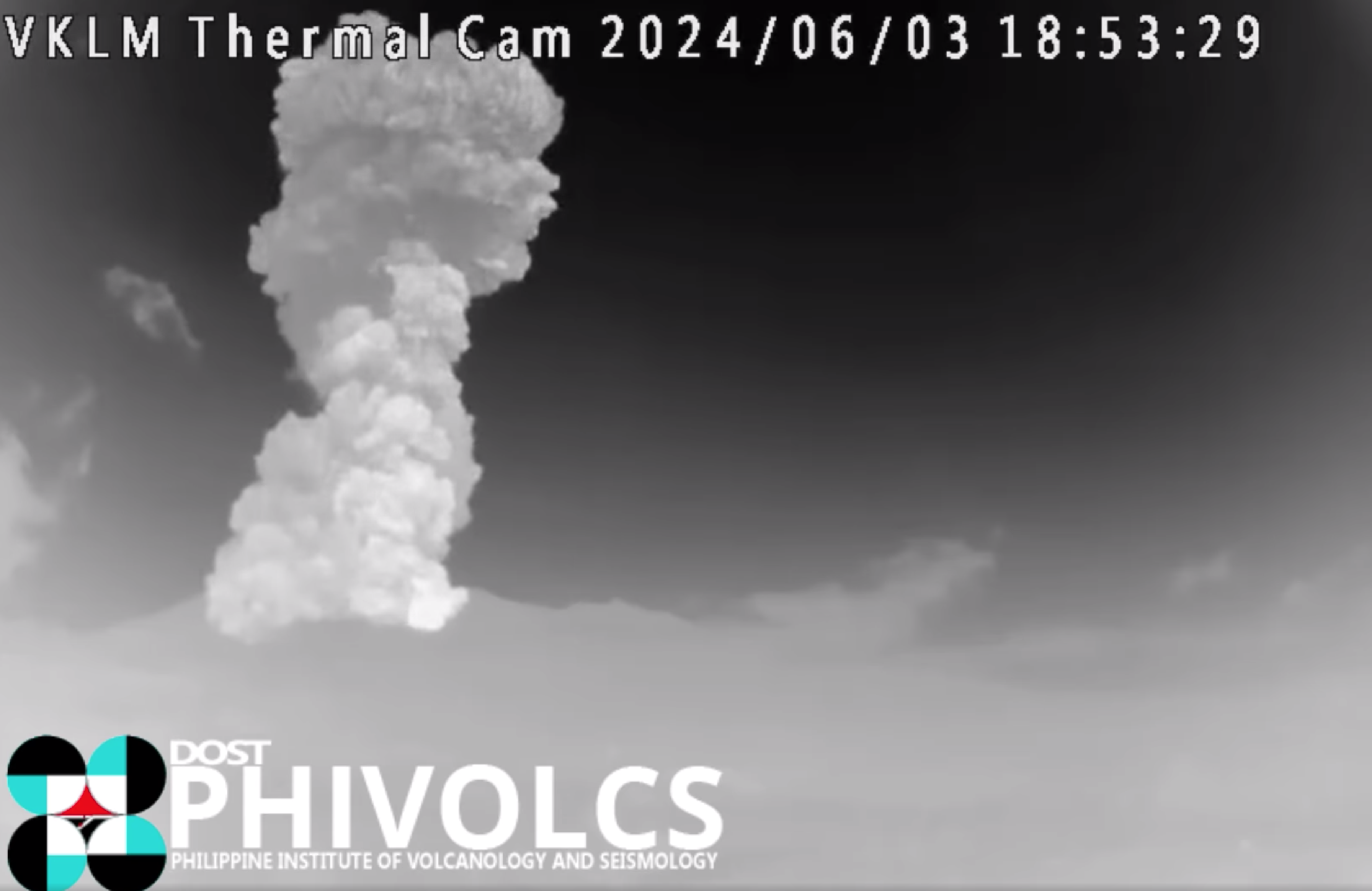
Timelapse IP Camera footage from 6:51 PM to 6:57 PM of the explosive eruption at the Kanlaon Volcano summit crater taken by the Lower Masulog (VKLM) observation station, 03 June 2024. The plume rose to 5000 meters above the vent. Incandescent ejecta can be seen to collapse from the plume and descend the southern upper slopes (towards the left foreground) as short pyroclastic density currents (PDCs). Screengrab from Philippine Institute of Volcanology and Seismology (PHIVOLCS-DOST)/FACEBOOK
MANILA, Philippines — Whether the Kanlaon Volcano’s eruption is phreatic or magmatic is still being studied by the Philippine Institute of Volcanology and Seismology (Phivolcs), the agency said Tuesday.
According to Phivolcs, the current classification for Kanlaon’s eruption is “explosive eruption.”
Phivolcs Volcano Monitoring and Eruption Prediction Division chief Antonia Bornas explained that “phreatic eruption” is the default classification for any minor initial eruption.
READ: Kanlaon Volcano erupts; Phivolcs raises Alert Level 2
However, data from the eruption prompted the agency to reassess the volcanic activity.
“Sa atin pong review, hindi tayo sigurado kung phreatic (In our review, we are not sure if it is phreatic) because of the strength of the eruption which was recorded by all seismic stations of Kanlaon volcano, and then we also witnessed incandescence,” said Bornas in a press conference.
Because of this, Bronas said Phivolcs staff collected ash samples from the eruption to check if it contained “juvenile magmatic material.”
“As of now, we are calling it an explosive eruption; the jury is still out on whether it’s a phreatic eruption,” she said.
A phreatic eruption is “steam-driven explosions that occur when water beneath the ground or on the surface is directly heated by hot rocks or new volcanic deposits or indirectly by magma or magmatic gas.”
On the other hand, an explosive eruption refers to an “energetic eruption that is driven mainly by the fragmentation of magma into ash, pumice or scoria and fragmental ballistic.”
For magmatic eruptions, Phivolcs explained to INQUIRER.net that such eruptions involve magma and are usually effusive or “quiet.”
It is usually characterized by two eruption types: Hawaiian and Strombolian. The former refers to non-explosive eruptions generating lava fountains and rivers, while the latter refers to explosive eruptions of basaltic magma.
Kanlaon’s last magmatic eruption was 122 years ago in 1902, while its last phreatic eruption was in December 2017.
Further eruptions may occur
As Phivolcs continues to monitor Kanlaon amid unrest, Bronas also warned that “chances of similar explosive eruptions occurring are significant” which increases the threat of volcanic hazards such as pyroclastic density currents and ballistic projectiles, especially in its permanent danger zone (PDZ).
“It can happen anytime as long as meron po tayong unrest ‘yung parameters po natin ay nagsasaad na meron tayong anomalies sa bulkan,” said Bronas.
(It can happen anytime as long as there is unrest; our parameters indicate that there are anomalies in the volcano.)
READ: OFWs assured of help as Mt. Kanlaon eruption cancels flights
Barangays within the PDZ include Ara-al and Yubo, La Carlota City; Sag-ang, Mansalanao, Cabagnaan, and Biaknabato in La Castellana; Minoyan, Murcia; Masolog, Pula and Lumapao, Canlaon City; and Codcod, San Carlos.
Kanlaon erupted on Monday night at exactly 6:51 p.m., lasting for six minutes and producing a plume that rose to 5,000 meters.
Currently, Phivolcs placed Kanlaon under Alert Level 2 and advised civil aviation authorities to avoid flying close to the volcano’s summit.